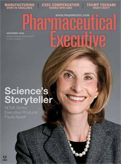- Sustainability
- DE&I
- Pandemic
- Finance
- Legal
- Technology
- Regulatory
- Global
- Pricing
- Strategy
- R&D/Clinical Trials
- Opinion
- Executive Roundtable
- Sales & Marketing
- Executive Profiles
- Leadership
- Market Access
- Patient Engagement
- Supply Chain
- Industry Trends
Science: The Communal Language
Pharmaceutical Executive
Despite Big Pharma's success in translating discovery research into products with proven clinical value, the industry continues to struggle in positioning medical research to the public as a distinctive force for good.
The biopharma industry is one of the mainstays of scientific research, serving as the critical gradient for the transition from basic to applied science. Without it, there is no end game: a therapeutically effective product used safely by patients in the real-world clinical setting. Without the extra effort from commercially motivated sponsors, ideas from basic research remain inanimate. It’s theory untested by practice, a scattered shot against the unforgiving linear trajectory of disease. The science itself might be stimulating, but sick people must have
William Looney

something more. A drug that works. For them.
By and large, big Pharma delivers spectacularly on this score. Over 90% of medicines available to patients today result from private-sector initiative in translating discovery research into products with proven clinical value. It’s a simple, verifiable statistic. Which raises the issue why the industry carries a reputational taint with the public and other stakeholders, who see it as guilty in overstating its contributions to innovation by exploiting government research subsidies and misrepresenting the real cost of its R&D spend to justify high introductory drug prices. Why are biopharma’s leading companies seen as somehow standing apart from the great products that clearly drives their success?
This month’s cover feature on Paula Apsell, senior executive producer of NOVA, the most successful television series on science, provides useful insight on tackling the public perception gap. With 43 years of broadcasting to back her up, Apsell’s advice is to apply the human touch. “Science is not a set of facts to be memorized but a process of learning about the changing world around us.” She tells Pharm Exec the way to talk about medical research is to highlight what Richard Feynman, the great popularizer of theoretical physics, called “the simple pleasure of finding things out.”
That curious, childlike approach to the big -and very human-questions addressed through drug development is often lost on the PR experts the industry usually relies on for reputational support. Pfizer has taken a step in the right direction with its new “Before it Became a Medicine” corporate advertising campaign, which focuses on the sweat equity expended on the average 12-year journey from proof-of-concept to an approved, patient-certified product-all without naming a single brand.
Nevertheless, we see a missed opportunity to position medical research to the public as a distinctive force for good-for the civilizing virtues of community in a siloed, disconnected world. The complexity of today’s molecular targets requires expertise from multiple disciplines, but nowhere in the Pfizer campaign so far is there reference to the need for external assets and collaborators to fuel the pipeline for new products. Coupled with the bump up in costly M&A and in-licensing deals, the omission reveals an inconvenient truth: even for the biggest of big Pharma, the journey from discovery to development to registration can no longer be pursued entirely in house. Pew Research Center polling reveals that a near-majority of Americans believes dinosaurs and humans walked the earth at the same time. Given that warped-if endearing-vision of a commingling of different species, doesn’t it make sense for big Pharma to raise its game with messaging to show the public what a real commitment to embracing diversity in research can accomplish?
Yes, it’s been said
Overall, we end the year at a pivotal time for the industry, marked by the erosion of 60 years of support for multilateral policy approaches linked to the globalization of markets, where the integrated biopharma enterprise is a principal beneficiary. Still, it is surprising how little the debate about biopharma’s reputation and its obligations to public health and society has changed.
Back in 1991, then-Merck CEO P. Roy Vagelos made arguably the most succinct-and prescient-case for a broader industry compact. In just five pages in the periodical Science, Vagelos set out clear positions on all the questions that dog the industry today:
- Research is hard, but the results are unusually cost-effective in the struggle against disease.
- Development of the breakthrough statin drug lovastatin took three decades of collaborative effort but was approved by the FDA after only nine months-a decision that struck the right balance between time and money, the key drivers of risk, and the benefits of enlightened partnerships with regulators.
- Fair access to medicines is an ethical obligation for big Pharma, and voluntary price restraint linked to public support for innovation is part of that. In fact, Merck committed to limiting US price increases to once a year, in line with the CPI rate.
Sound familiar? It is-fresh back to 1991. Maybe what is needed today is a commitment not to study, but to act.
William Looney is Editor-in-Chief of Pharm Exec. He can be reached at william.looney@ubm.com. Follow Bill on Twitter: @BillPharmExec

Key Findings of the NIAGARA and HIMALAYA Trials
November 8th 2024In this episode of the Pharmaceutical Executive podcast, Shubh Goel, head of immuno-oncology, gastrointestinal tumors, US oncology business unit, AstraZeneca, discusses the findings of the NIAGARA trial in bladder cancer and the significance of the five-year overall survival data from the HIMALAYA trial, particularly the long-term efficacy of the STRIDE regimen for unresectable liver cancer.
Novel GLP-1 Receptor Agonist Demonstrates Promising Results Treating Patients with Obesity
January 21st 2025Data from a Phase Ia single ascending dose study found that ASC30 demonstrated dose-proportional pharmacokinetics, a half-life of up to 60 hours, and superior pharmacokinetic properties compared to other oral GLP-1 receptor agonists.
Cell and Gene Therapy Check-in 2024
January 18th 2024Fran Gregory, VP of Emerging Therapies, Cardinal Health discusses her career, how both CAR-T therapies and personalization have been gaining momentum and what kind of progress we expect to see from them, some of the biggest hurdles facing their section of the industry, the importance of patient advocacy and so much more.
Artificial Intelligence Makes Possible a Multiomic Approach in Oncology Drug Discovery
January 7th 2025While challenges remain, AI is accelerating the process by enabling researchers to identify and design new drug candidates more quickly and efficiently with applications in target discovery, structure prediction, and drug optimization.
